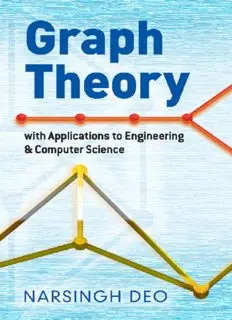
Graph Theory with Applications to Engineering and Computer Science PDF
Preview Graph Theory with Applications to Engineering and Computer Science
Graph Theory with Applications to Engineering & Computer Science NARSINGH DEO Millican Chair Professor, Dept. of Computer Science Director, Center for Parallel Computation, University of Central Florida DOVER PUBLICATIONS, INC. Mineola, New York Copyright Copyright © 1974 by Narsingh Deo All rights reserved. Bibliographical Note This Dover edition, first published in 2016, is an unabridged republication of the work originally published in 1974 by Prentice-Hall, Inc., Englewood Cliffs, New Jersey. Library of Congress Cataloging-in-Publication Data Names: Deo, Narsingh 1936– Title: Graph theory with applications to engineering and computer science / Narsingh Deo. Description: Dover edition. | Mineola, New York: Dover Publications, 2016. Originally published: Englewood Cliffs, New Jersey: Prentice-Hall, Inc., 1974. | Includes bibliographical references and index. Identifiers: LCCN 2016008025 | ISBN 9780486807935 | ISBN 0486807932 Subjects: LCSH: Graphy theory. | Engineering mathematics. Classification: LCC TA338.G7 D46 2016 | DDC 511/.5—dc23 LC record available at http://lccn.loc.gov/2016008025 Manufactured in the United States by RR Donnelley 80793201 2016 www.doverpublications.com To the memory of my father, who did not live to realize his greatest ambition— that of witnessing his eldest son matriculate. CONTENTS PREFACE 1 INTRODUCTION 1-1 What is a Graph? 1-2 Application of Graphs 1-3 Finite and Infinite Graphs 1-4 Incidence and Degree 1-5 Isolated Vertex, Pendant Vertex, and Null Graph 1-6 Brief History of Graph Theory Summary References Problems 2 PATHS AND CIRCUITS 2-1 Isomorphism 2-2 Subgraphs 2-3 A Puzzle With Multicolored Cubes 2-4 Walks, Paths, and Circuits 2-5 Connected Graphs, Disconnected Graphs, and Components 2-6 Euler Graphs 2-7 Operations On Graphs 2-8 More on Euler Graphs 2-9 Hamiltonian Paths and Circuits 2-10 The Traveling Salesman Problem Summary References Problems 3 TREES AND FUNDAMENTAL CIRCUITS 3-1 Trees 3-2 Some Properties of Trees 3-3 Pendant Vertices in a Tree 3-4 Distance and Centers in a Tree 3-5 Rooted and Binary Trees 3-6 On Counting Trees 3-7 Spanning Trees 3-8 Fundamental Circuits 3-9 Finding All Spanning Trees of a Graph 3-10 Spanning Trees in a Weighted Graph Summary References Problems 4 CUT-SETS AND CUT-VERTICES 4-1 Cut-Sets 4-2 Some Properties of a Cut-Set 4-3 All Cut-Sets in a Graph 4-4 Fundamental Circuits and Cut-Sets 4-5 Connectivity and Separability 4-6 Network Flows 4-7 1-Isomorphism 4-8 2-Isomorphism Summary References Problems 5 PLANAR AND DUAL GRAPHS 5-1 Combinatorial Vs. Geometric Graphs 5-2 Planar Graphs 5-3 Kuratowski’s Two Graphs 5-4 Different Representations of a Planar Graph 5-5 Detection of Planarity 5-6 Geometric Dual 5-7 Combinatorial Dual 5-8 More on Criteria of Planarity 5-9 Thickness and Crossings Summary References Problems 6 VECTOR SPACES OF A GRAPH 6-1 Sets with One Operation 6-2 Sets with Two Operations 6-3 Modular Arithmetic and Galois Fields 6-4 Vectors and Vector Spaces 6-5 Vector Space Associated with a Graph 6-6 Basis Vectors of a Graph 6-7 Circuit and Cut-Set Subspaces 6-8 Orthogonal Vectors and Spaces 6-9 Intersection and Join of W and Ws Summary References Problems 7 MATRIX REPRESENTATION OF GRAPHS 7-1 Incidence Matrix 7-2 Submatrices of A(G) 7-3 Circuit Matrix 7-4 Fundamental Circuit Matrix and Rank of B 7-5 An Application to a Switching Network 7-6 Cut-Set Matrix 7-7 Relationships among A , B , and C f f f 7-8 Path Matrix 7-9 Adjacency Matrix Summary References Problems 8 COLORING, COVERING, AND PARTITIONING 8-1 Chromatic Number 8-2 Chromatic Partitioning 8-3 Chromatic Polynomial 8-4 Matchings 8-5 Coverings 8-6 The Four Color Problem Summary References Problems 9 DIRECTED GRAPHS 9-1 What Is a Directed Graph? 9-2 Some Types of Digraphs 9-3 Digraphs and Binary Relations 9-4 Directed Paths and Connectedness 9-5 Euler Digraphs 9-6 Trees with Directed Edges 9-7 Fundamental Circuits in Digraphs 9-8 Matrices A, B, and C of Digraphs 9-9 Adjacency Matrix of a Digraph 9-10 Paired Comparisons and Tournaments 9-11 Acyclic Digraphs and Decyclization Summary References Problems 10 ENUMERATION OF GRAPHS 10-1 Types of Enumeration 10-2 Counting Labeled Trees 10-3 Counting Unlabeled Trees 10-4 Pólya’s Counting Theorem 10-5 Graph Enumeration With Pólya’s Theorem Summary References Problems 11 GRAPH THEORETIC ALGORITHMS AND COMPUTER PROGRAMS 11-1 Algorithms 11-2 Input: Computer Representation of a Graph 11-3 The Output 11-4 Some Basic Algorithms Algorithm 1: Connectedness and Components Algorithm 2: A Spanning Tree Algorithm 3: A Set of Fundamental Circuits Algorithm 4: Cut-Vertices and Separability Algorithm 5: Directed Circuits 11-5 Shortest-Path Algorithms Algorithm 6: Shortest Path from a Specified Vertex to Another Specified Vertex Algorithm 7: Shortest Path between All Pairs of Vertices 11-6 Depth-First Search on a Graph Algorithm 8: Planarity Testing 11-7 Algorithm 9: Isomorphism
